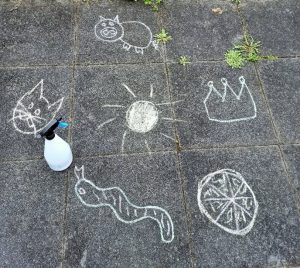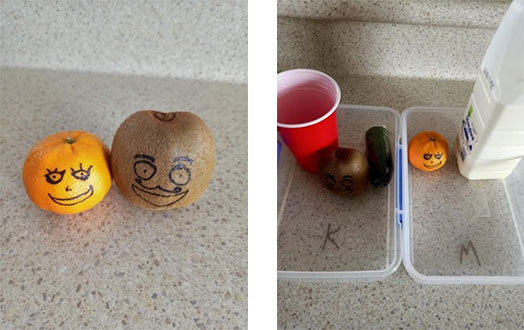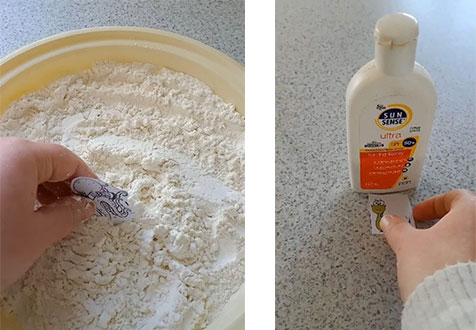TIME TO GET OUT DOORS!!!
With summer right around the door it’s time to get outdoors and have some fun. As you have probably experienced, it can be pretty tricky to get a child to sit down and work at the table.
So below are some fun and exciting activities you can do with your kids inside and outside, which still provide lots of learning opportunities.
Letter Shapes
Letters can be drawn on the ground with chalk, shaped in the garden using stones, and even created when cooking pancakes. You can use various materials to draw and create different letters for your child to learn. Use different coloured pancake mix or beaten egg to make pictures which can be matched or sorted by initial/final sound.
Possible focus:
- Practice identifying letters
- Practice writing letters
- Find/spray/bury a letter that matches a given letter sound
- Spray the initial or final letter of a given word e.g. king starts with /k/
- Sort given items between sounds, use the letters as headings
Chalk Pictures
Chalk can be great to use outside. You can draw different pictures for your child to jump on or spray with water.
Possible focus:
- Spray or jump on items starting/ending with a specific sound or that belongs to a particular category
- Play giant bingo covering up items
- Play twister where you must put your hand/foot on a specific item (by category, letter sound, colour)
- You can also add it to an obstacle course
Obstacle courses
Using random household objects and a bit of chalk, you can create great obstacle courses for your child to run through. During the obstacle course we can use the core board and signing to give directions e.g., jump up and down. This can also support learning of preposition words such as in, out, over, and under. You can then add in other activities as part of the course for example; word spraying at the end. If you have multiple goals to be focusing on, you can set each part of the course to focus on one thing. For example, your child can jump out a syllable word (3x jumps for potato) and they can spin while stretching out a long speech sound (ssssssssun).
Possible focus:
- Building instruction following
- Modelling the core board
- Learning prepositions
- Active movement
- Counting steps or spins
To see an example, click on the following links:
Course demo
Course run through
Fruit friends
You can find items to represent a specific letter sound such as Molly Mandarin and Karl Kiwifruit. As you’ll see in the video, you can then create homes for them where other items starting with the same sound belong e.g., cup and cucumber for Karl. As explained in the video you can also use the friends to play hide and seek or name where they are placed around the room or in the garden (Molly is on the microwave).
Possible focus:
- Identifying initial sounds
- Practicing speech sounds (name all the items in the box)
- Using location words
To watch an explained video, click here
Item hunt
Fill a dish or tray with flour, dirt, sand, coloured water and then put in items which either start with different sounds, or the same sound you are focusing on. Get your child to put their hand in and dig/search for an object then pull out and name it, highlighting the initial sound. Alternatively, hide a character or object representing a focus sound, around the room next to things that begin with the same sound.
To watch explained videos, click on the links
Flour Hunt
Snake Search
Other Initial sounds games
Eye spy: Search for things beginning with the same or different initial sounds. Look around the house, garden, while on a walk. You could change this by writing letters on bits of paper and then getting your child to put a letter on something that starts with that letter sound.
Letter baking: Make cookies, pancakes, pastry, or use playdough and shape into different letters for your child to identify.
Art creations: Give your child a letter sound and get them to make something that begins with that sound e.g. a snake for /s/. Or do it the other way around and draw/paint/create things that can be named and the initial sound is identified.
Hop scotch/jumping: Place pictures or objects on the ground for your child to jump to. When they jump on the word they need to say it out loud and identify the initial sound.
Posting: Set up three boxes, one with a different target sound and then get your child to sort items depending on their initial sound e.g. sock goes into /s/, pillow goes into /p/.
Fear factor: Cover a box with different items for your child to reach in and pull out. They can then identify what the initial sound of that item is and could then sort the different items by initial sound. You could create a food tasting game where your child has to figure out what the food is and then identify the initial sound of what it might be (/v/ for vegemite).
Syllable games
Hopscotch: Jump through according to the number of syllables in a given word. Similarly, you could jump on chalk drawings according to how many syllables the word has (dinosaur = 3x).
Water squirt: Spray a chalk picture according to the number of syllables in a word.
Turn taking games: Use the number of syllables in a word as your dice for a game. If a word has two syllables, you take two steps/moves/turns.
Snack time: You could give your child a word to clap out, in which they then get the same number of crackers/raisins/pieces of fruit/cookies etc. as the number of syllables (2x cookies for ‘dragon’).
Written by
Lacie Glen Vile
Speech Language Therapist












